Would you ever move into a home with cracks in the walls and gaps opening near windows or doors that let small critters crawl around and slowly demolish your home? Probably not, right?
Well, why did you build a site for your business that has low site authority, isn’t user friendly, doesn’t prioritize search engine optimization, and has a poor site structure? Sorry if that was harsh; we just want the best for you.
In this blog, we’ll help your business renovate and restore your poorly built home and show you how you can give it a great SEO-focused foundation that helps your content show up on the most valuable search engine results pages (SERP) for your business and deliver a top-tier experience for your visitors.
Why You Should Care About Your Site Structure
Site structure is the foundation that allows search engines to crawl your site and understand what your website is about. With a poorly-built site structure, Google can have trouble indexing your pages, which can result in your pages not showing up in search results…ouch…If that’s not bad enough, a poor site structure can make your site’s user experience garbage, resulting in visitors running faster than a turkey on Thanksgiving. It’s really a lose-lose situation to not prioritize site structure.
How SEO Weaves Itself into Site Structure
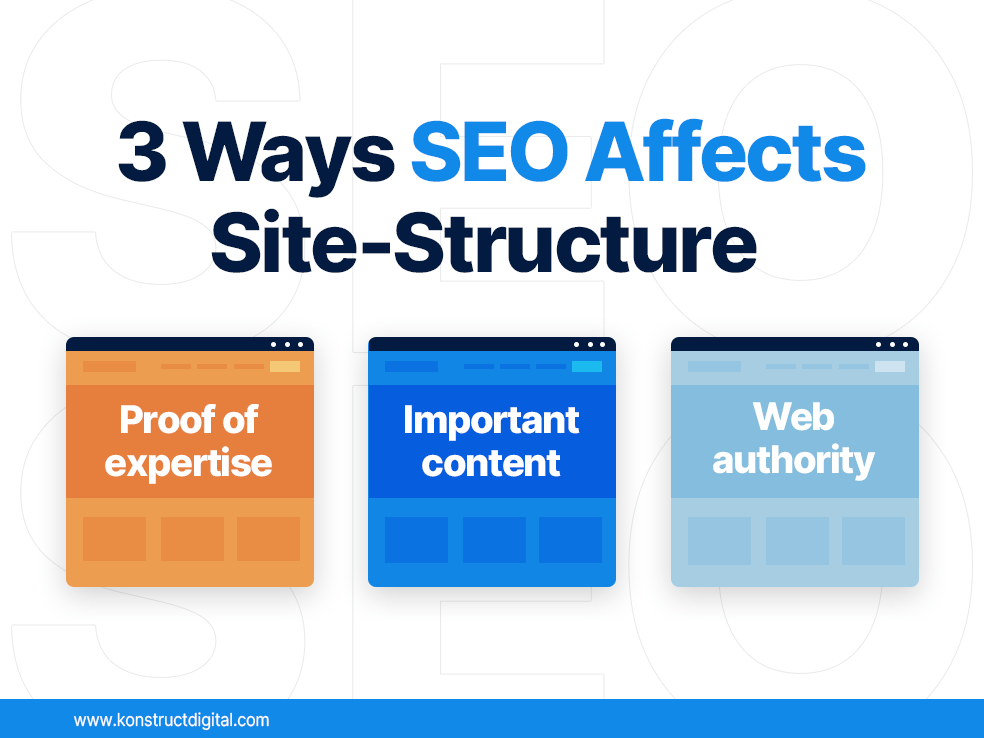
As any digital marketer knows, SEO is key to a successful marketing strategy. Without having a solid SEO strategy, you’re essentially trying to drive a car with no transmission. With SEO affecting so much of your site, it only makes sense that it also means a lot to your site structure. Let’s take a look at some ways SEO directly affects your site structure:
1. Proof of Expertise
Search engines want to promote good behaviour, like a dog in training. When you prove that you’re an expert in your field, search engines will trust your site, give you a treat, and help rank your content.
One of the best ways you can prove your depth of knowledge through your site structure is by grouping your content. Groupings will help Google understand your site’s navigation, proving that you aren’t a B-level business and actually know what you’re doing. Here’s what this looks like:
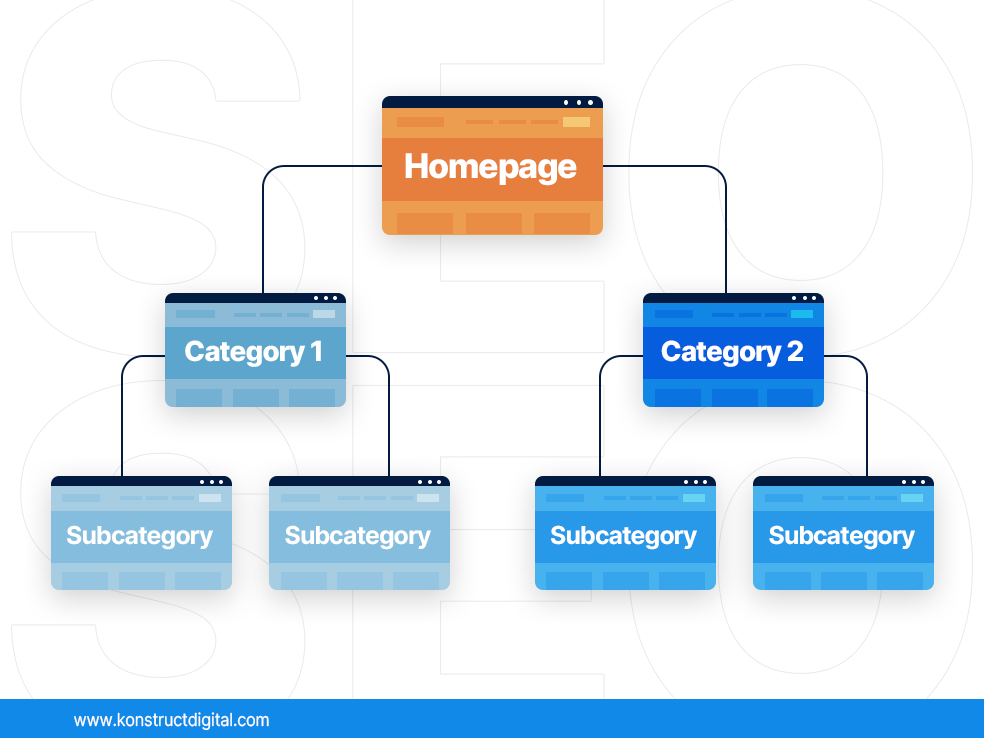
2. Important Content
Content near the top of your site hierarchy (also known as pillar or hub pages) is often targeted toward competitive keywords with a high search volume. For example, let’s say you sell all types of sweets (chocolate, candy, unique snacks, etc.). You may have “candy” as one of your hub pages. Then, your subcategory pages may be something like “sour candy”, “hard candy”, “lollipops,” etc., (yes, the candy craving is real right now.). Your goal here is to provide users with the perfect page that is most related to their search. If they search “sour candy”, you want your “sour candy” page to rank first.
You might be wondering “well why do I want to target my high-volume keywords at the top of my site structure then?”, and the answer is because these pages have more page authority so targeting these high-value keywords will help them rank for more competitive keywords and drive more traffic to your site. Now, we aren’t saying don’t use high-value keywords for your subcategory pages; just prioritize your hub pages as the most important.
3. Web Authority Through Internal Linking
Similar to our last point, pages near the top of your site architecture carry more page authority. These hub pages have more important content and link authority on your website. Properly linking these pages to other pages and having a site structure that supports good internal linking helps pass page authority (also referred to as “link juice”) to pages lower down in the site structure, helping these pages rank better on search engines. It’s like an inheritance from your hub pages to your subcategory pages!
3 Site Structures to Know, 1 Site Structure You’ll Love
On August 6th, 1991, site structure was born. Just like you and I, people have come into its life and helped it grow, evolve, and adjust to modern technology. After three decades with some struggles and some wins, four primary structures remain:
1. Hierarchical Website Structure
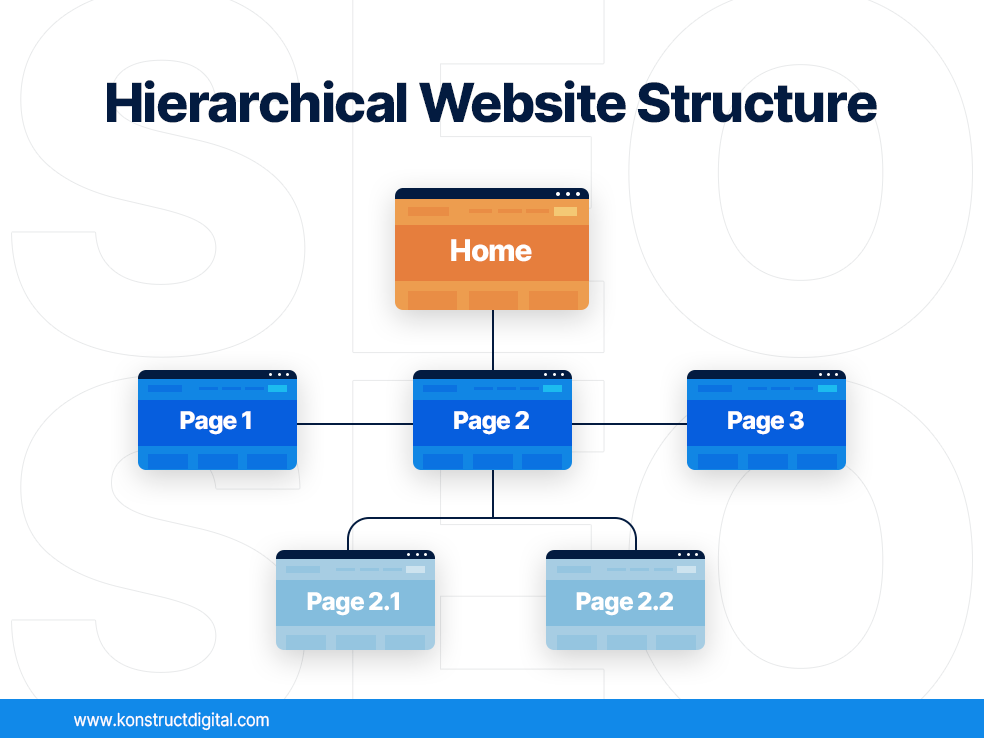
The hierarchical structures are the most common structure types because they are logical and easy to understand by users and Google. They follow a top-down approach that allows copious amounts of content to fit within the site perfectly.
2. Linear Website Structure
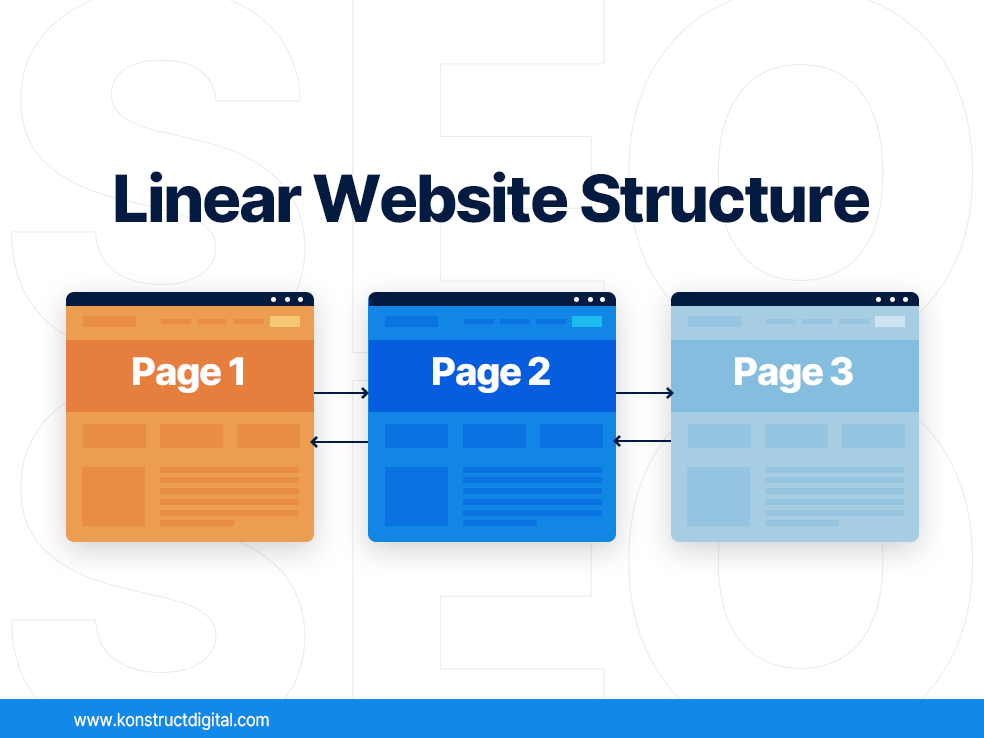
A linear website structure is straightforward to understand (if you have less than five pages on your site). Typically, you’ll see this structure on small business sites or sites that just don’t have a lot of content.
3. Webbed Website Structure
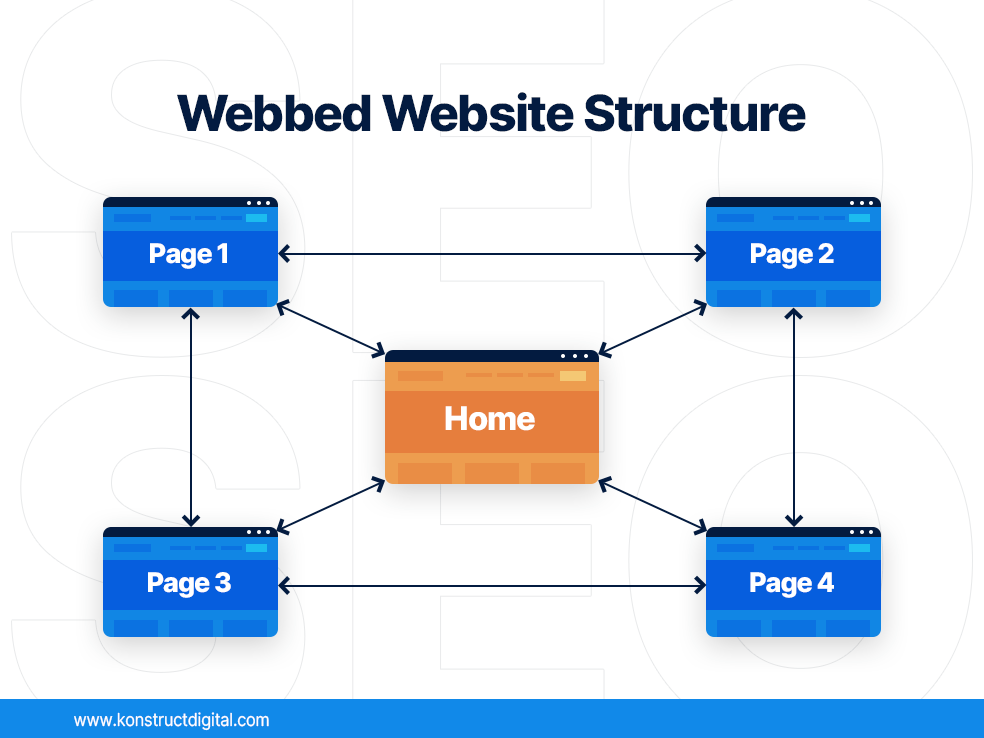
A webbed structure is a structure that links all pages together so users can quickly and easily find what they need. Although linking pages is important, this structure can be somewhat confusing and illogical–especially if you have a handful of product or service pages.
4. Database Website Structure
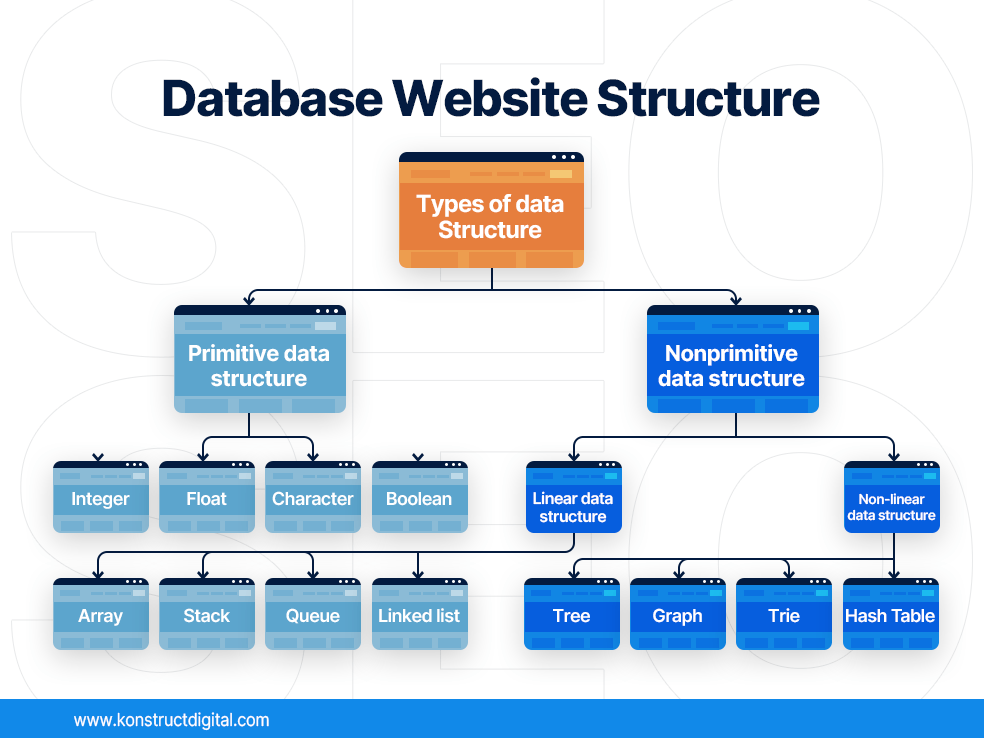
Database structures use a bottom-up approach, opposite of a hierarchical structure, and are one of the most challenging structures to create. This structure relies heavily on tagging and metadata to make pages searchable and accessible. If you’re leaning towards this structure type, you’ll need a killer developer–we know a great place to find one (hint: it’s us!).
“Which Site Structure is the Best?”
Now, we could dive even deeper into all site structures and their little details. But, if you’re a B2B business that cares equally about SEO and UX on your site (which you should), hierarchical structures are where it’s at. Hierarchical structures offer the best results from an SEO and UX perspective, and we believe they are the most SEO-friendly website structure type.
Let’s break this down: A B2B website will typically offer multiple services or products and will need landing pages for each. Grouping these services into content groupings and creating hierarchies around these groupings allows search engines to understand your content focus, determine your expertise around a topic and easily discover content. This type of site structure is also very familiar to users, making for a better user experience. If site structures were teams, we’d be hierarchical’s number #1 fan.
Important Factors to Consider When Creating Your Site Structure
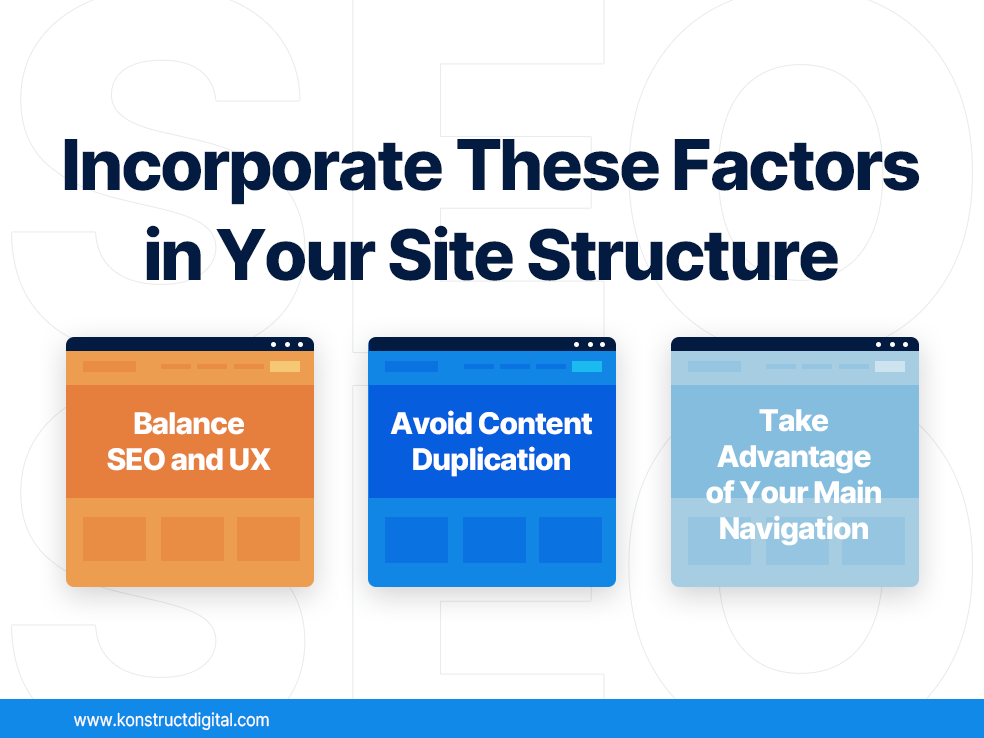
We know you’re eager to create your site structure, but we have one more thing to cover: important to consider when creating your structure.
Balancing SEO and UX
If there’s one thing we’re major advocates of, it’s balancing SEO and UX. If you have good search engine optimization, sure, more people will find your site, BUT, it won’t matter if they immediately leave your site because their experience was horrible.
All successful websites have a great combination of both SEO and UX. The best part is your SEO doesn’t have to suffer in the name of a great UX or vice versa. If you’re interested in learning more about SEO and UX, be sure to read our blog post, SEO and UX: The Ultimate Landing Page Showdown! TLDR? Always balance SEO and UX if you’re looking for results.
Avoid Content Duplication
Unfortunately, you can’t take one of your service pages, duplicate it and mad libs the content to fit within the context of individual web pages. If you’re thinking, “Oh s***, I don’t want to write all of the content on my site from scratch,” you may need a content writer. Don’t stress, our content team can help!
Because each of your pages aims to rank for its individual keywords, if you take the same content and duplicate it on many pages of your site, you will see your pages competing on the search results pages. Participating in a competition as a winner and loser isn’t as fun as coming out strictly on top.
Take Advantage of Your Main Navigation
Would you rather drive to a location you’ve never visited before with or without navigation? Probably with, right? The same relates to your site navigation. If you don’t have a logical main navigation on your site, visitors may struggle to find the page they’re looking for and end up in a dodgy part of town, have a terrible user experience, or worse, leave your site and turn to your competitors. If you have user-friendly navigation, users are more likely to convert and return to your site for more. Take advantage of your site navigation when creating your site structure, so you can consider how a visitor may travel through your site.
Getting to Work
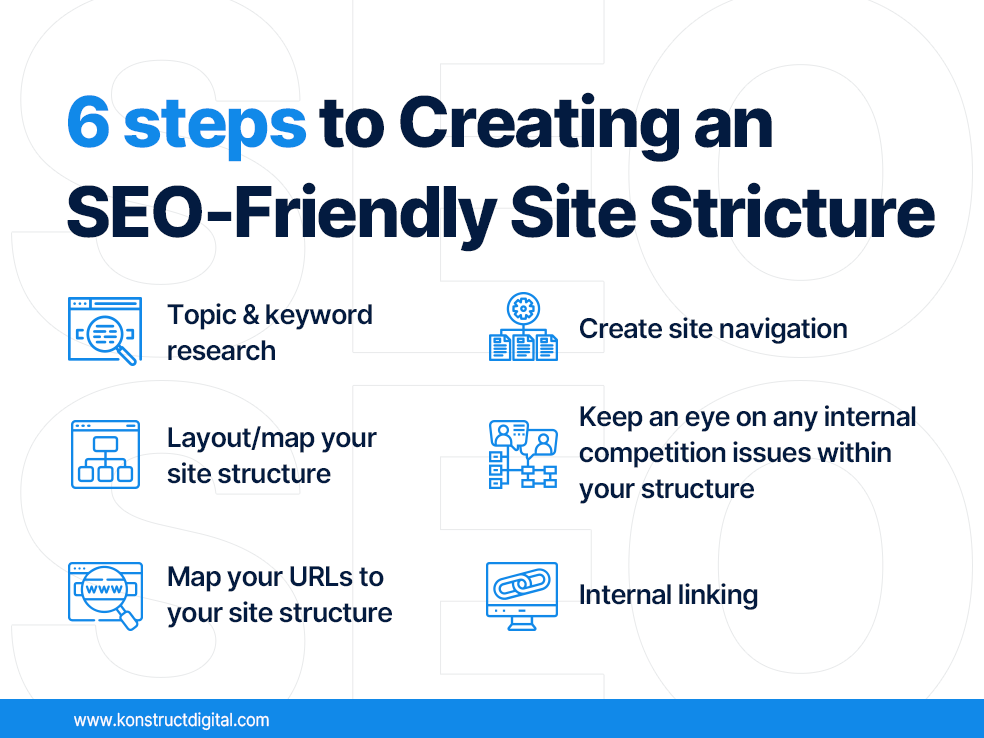
The time has finally come! Now that you’ve developed your technical knowledge and basic understanding of site structure, you’re ready to jump head first into the steps of creating a quality site structure. Let’s dive in.
1. Topic & Keyword Research
Before creating your site structure, make sure you’ve completed your keyword research. Otherwise, you’re building a home without any frames. Keyword research is the process of researching and finding relevant terms or phrases that your target audience searches, which ultimately helps users find your site.
If you haven’t completed your keyword research, read our blog, How to do Keyword Research, and then come back here for step #2! If you already know what keywords you want to target, great! It’s time to create your layout.
Don’t forget: Every page on your site should target one primary keyword as well as a few secondary keywords. Google crawls your site and uses latent semantic indexing (LSI) to identify the topics of each page on your site. This then helps Google better understand your site and what it’s about.
2. Layout/Map Your Site Structure
Bring out your inner Van Gogh and draw a rough draft of your site structure. This will help you visualize your hierarchy clearly and identify any opportunities you may miss. After drafting your structure, sit back and take a hard look at all of the pages you’ve included and make sure it’s logical to both users and search engines without any clutter. In this step, make your structure simple and logical without adding any unnecessary content.
Consider these stats from KoMarketing when creating your site structure
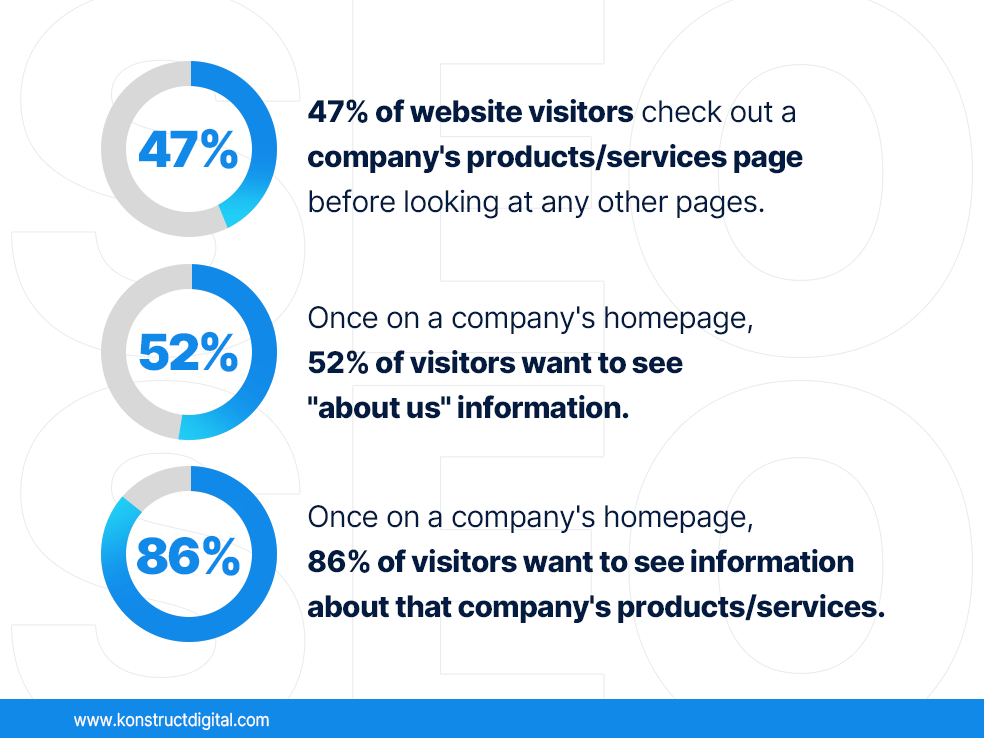
Here’s a reminder of how you should layout your site structure:
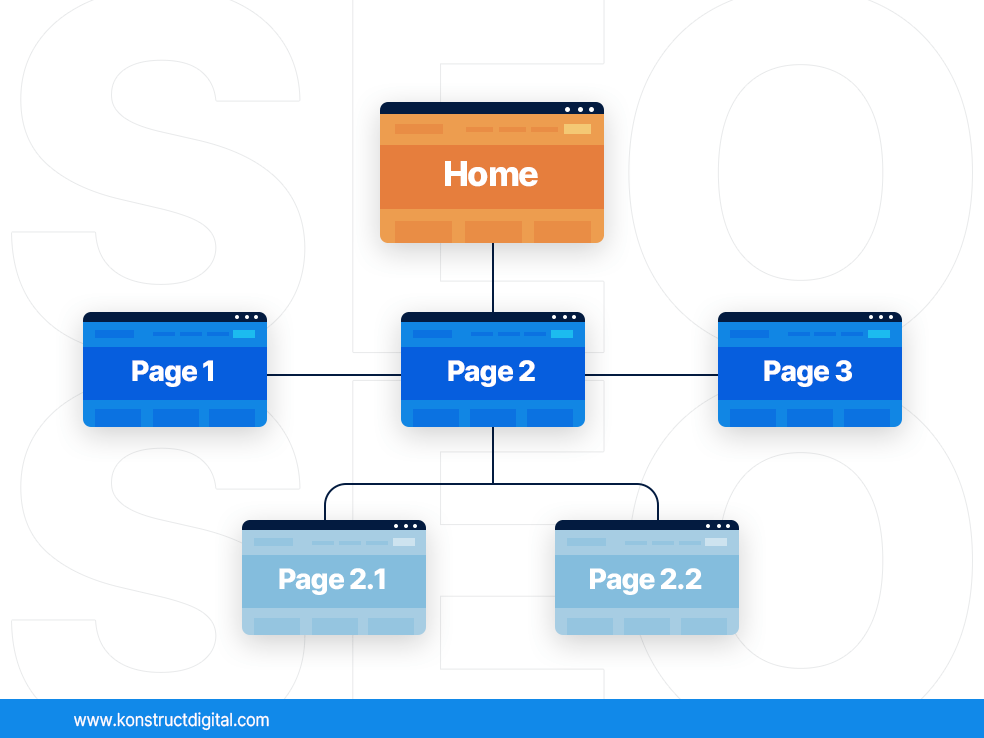
3. Map Your Urls to Your Site Structure
Now that you’ve made a layout, it’s time to create your URLs. Here’s an example of the URLs in a site structure:
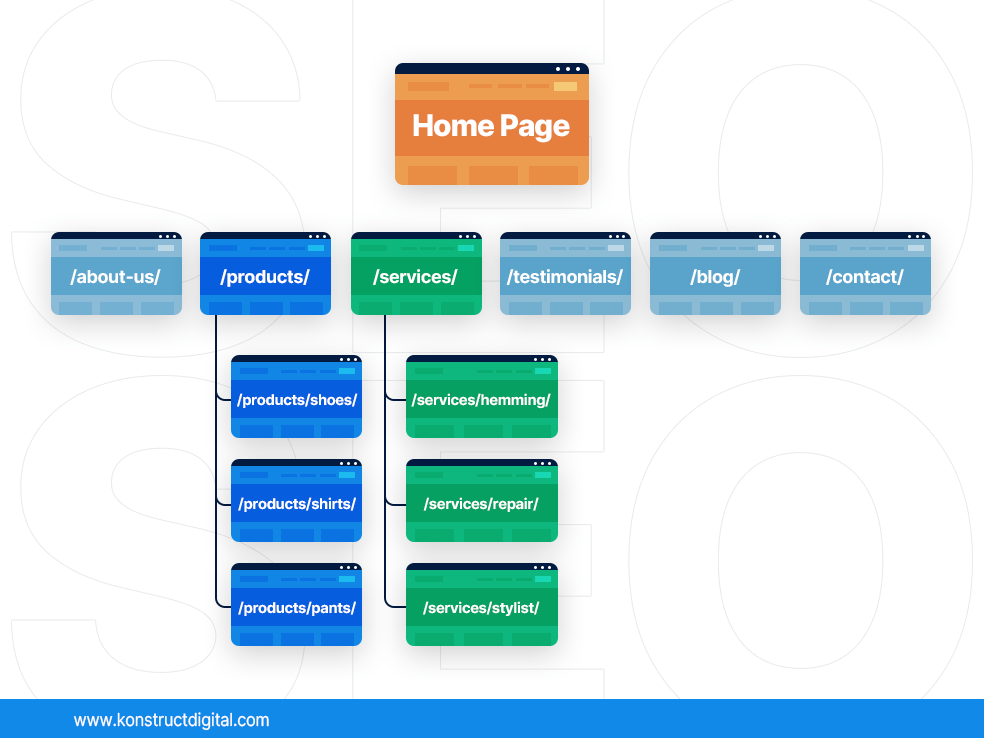
As you can see, URLs should mimic and represent each category and subcategory in the structure. Both users and search engines should be able to look at a URL and know exactly where they are on your website.
So, your URLs should be properly nested to reflect your site structure, with your slugs matching the page topic. For example, let’s say you’re a business selling insurance; your URLs may look something similar to:
Your category services page:
www.yourbusiness.com/services/
Your subcategory services may look something like the following:
www.yourbusiness.com/services/car-insurance/
www.yourbusiness.com/services/home-insurance/
4. Create Site Navigation
Remember when we told you site navigation was an important factor when creating a site structure? We didn’t lie!
Now that you’ve determined your site structure and your page’s corresponding URLs, it’s time to create your site navigation. Site navigation is basically your drawn site structure coming to life. For reference, here’s an example of our site structure on the main navigation:
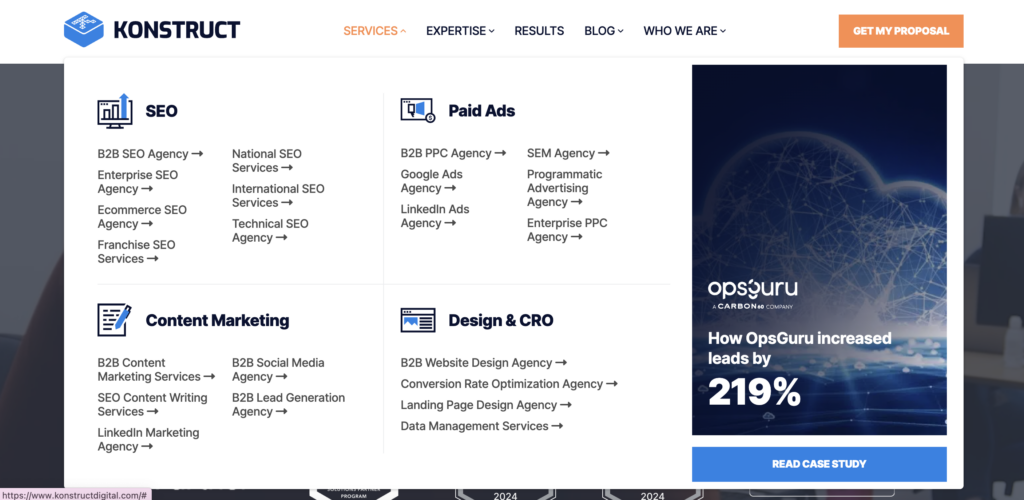
As you can see, your homepage will most likely be the first that shows up when someone clicks on your site (unless they’re landing on one of your landing pages via a Google search or a paid ad). Then, visitors can browse through your site and easily find their desired page. Not only is this important for when users visit your site, but also when search engines crawl your site.
At this point, feel free to send your site structure to your development team so they can help bring your new site to life!
5. Keep an Eye on Any Internal Competition Issues Within Your Structure
We’re mentioning duplicate content again…we don’t want you to forget this!
At this step, you must ensure topics are only covered on one page. We don’t mean the same words or sentences; we mean don’t copy and paste your content to every single page. Just a reminder, if you use duplicate pages for the same topic, it will cause internal competition preventing all pages covering that topic from ranking as effectively as they would if they were just on one page.
6. It’s Internal Linking Time
If your main goal is to rank on search engines, don’t skip this step! Actually, never skip this step. Pointing one page to another relevant page is important for making pages discoverable and for sharing the page authority from one page with another. Internal linking basically says, “Hey Google, this link is important and links to this other important page.” This helps Google better understand your site and help you rank higher on the SERP.
Pro tip: As you add pages to your site, create effective linking strategies, like adding new internal linking every time you add a new page to your site so you can keep your site up to date.
Create an SEO-Friendly Site Structure with Expert Assistance
Congratulations on making it to the end! We know this was a long one to read, but hey, the Roman Empire wasn’t built in one day, and neither is your SEO site structure.
If you think your current site structure negatively impacts your UX and SEO, it’s probably time you get expert help. With over a decade of experience, there’s no one better prepared to build your site structure than our SEO team. Here are 6 things we’ll do for you:
- Provide insightful keyword research that helps you understand an effective hierarchy for your website
- Develop an effective internal linking strategy to make sure your site structure effectively passes page authority and link juice throughout your website
- Build a site structure that will help your website rank on search engines
- Create an effective URL structure that will complement your site structure
- Maximize site crawlability with our expert knowledge of how search engine crawlers work
- Make sure your content is found by top search engines
At Konstruct, we’re competitive. We live by the great quote from Ricky Bobby, “If you ain’t first, you’re last”. We don’t settle for low page rankings, so you shouldn’t either. If you’re looking for support in building a site structure that will help your site rank on search, contact us! Everyone needs a little more structure in their life, and right now, it’s your website.
Need help with B2B SEO?
Learn more about Konstruct's B2B SEO Services
More B2B SEO Resources
- Why Reacting Too Fast to SEO Changes is Killing Your Campaigns
- The Importance of In-Audience and Out-of-Audience TOFU Content for B2B SEO
- Are You Ready for SEO? The Question You Should Be Asking
- SEO is Never Really Done
- Generative Engine Optimization: Why Your SEO Strategy Needs to Evolve
- How to Select High-Impact Keywords for B2B SEO
- Why ‘Learn More’ Links Are Hurting Your SEO (and What to Use Instead)
- Why Your Landing Pages Shouldn’t Target Too Many Keywords
- How to Tell if a Keyword Actually Works for Your B2B Business
- How Should B2B Businesses Identify Target Keywords


